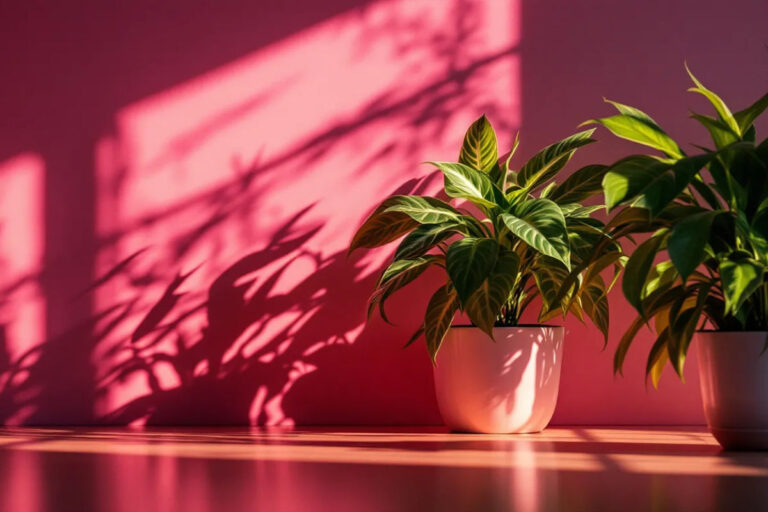This post may contain affiliate links. If you make a purchase through these links, we may earn a commission at no additional cost to you.
Gardening starts with a single step: picking plants that match your slice of the U.S. The USDA Plant Hardiness Zones split the country into 13 bands, each defined by its average minimum winter temperature. We’ll cover the best outdoor plants for beginners in every one—from the bone-chilling -60°F of Zone 1 in Alaska to the frost-free 40°F-and-up of Zone 13 in Hawaii. These zones aren’t just numbers; they’re your cheat code to growing success.
|
Zone # |
Avg. Min. Temp (°F) |
Key Characteristics |
|---|---|---|
|
1 |
Below -50 |
Tundra-like, permafrost, very short growing season |
|
2 |
-50 to -40 |
Subarctic, long winters, limited frost-free days |
|
3 |
-40 to -30 |
Cold winters, short summers, moderate snow cover |
|
4 |
-30 to -20 |
Harsh winters, reliable snow, 3-5 month growing season |
|
5 |
-20 to -10 |
Cold winters, mild summers, frost common in spring/fall |
|
6 |
-10 to 0 |
Moderate winters, warm summers, longer frost-free period |
|
7 |
0 to 10 |
Mild winters, hot summers, occasional light frost |
|
8 |
10 to 20 |
Warm winters, long hot summers, rare frost |
|
9 |
20 to 30 |
Very mild winters, extended growing season, dry summers |
|
10 |
30 to 40 |
Subtropical, minimal frost, year-round growing possible |
|
11 |
40 to 50 |
Tropical-like, no frost, consistently warm and humid |
|
12 |
50 to 60 |
Hot and humid, arid in some areas, extreme heat possible |
|
13 |
Above 60 |
Very hot, minimal seasonal variation, coastal influence |
Whether you battle blizzards, bask in temperate springs, or sweat through endless summers, your zone reveals what thrives where you live. Beginners, take note—you don’t need skills to start. You need plants that forgive rookie missteps and flourish anyway.
This guide delivers exactly that: the easiest outdoor plants for every U.S. zone, hand-picked for novices like you. We scoured the map to find winners that laugh at tough weather, shrug off neglect, and still dazzle your yard. In cold Zones 1-4, you’ll meet hardy survivors that bloom despite snow. Temperate Zones 5-7 offer versatile beauties that balance hot and cold. Warm Zones 8-10 bring heat-loving stars that stretch the growing season long. And tropical Zones 11-13? They hand you lush, year-round showstoppers. Every plant here shares three traits: low maintenance, resilience, and a knack for making you look good.
Grow Easy: Top Outdoor Plants for Beginners in Every U.S. Zone
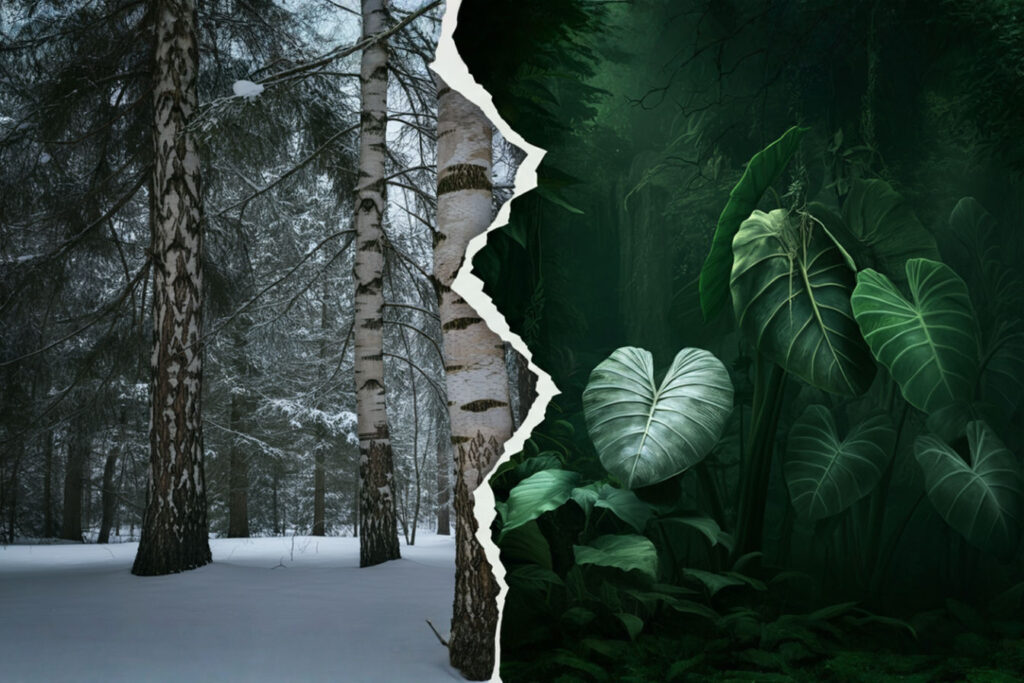
Why these? Because starting small beats starting stressed. No fancy gear, no green thumb required—just sunlight, water, and a little dirt under your nails. These plants grow with you, teaching you the ropes as they sprout, bloom, or climb. They’re your ticket to a yard that hums with life, no matter your climate.
Picture this: you dig a hole, drop in a starter, and watch it take off. That’s the confidence boost every beginner craves. This article walks you through each zone, spotlighting plants that turn “I can’t” into “I did.” You’ll get climate snapshots, simple how-tos, and tips to dodge common pitfalls—all tailored to your corner of the country. Curious which ones fit your zone? You’re about to find out.
Grab your ZIP code and head to the USDA website to pinpoint your zone. Then dive in. These picks promise gardening wins from day one—whether you’re thawing out in spring or planting under a tropical sun. Start easy, grow bold, and transform your outdoor space. Ready to dig in?
Cold Zones (1-4) – Tough Plants for Harsh Winters
Zones 1-4 span the U.S.’s iciest regions, from Alaska’s tundra to the northern Plains. Average minimum winter temperatures dip between -60°F and -20°F, and growing seasons shrink to 60-100 days. Expect heavy snow, late springs, and early frosts—tough conditions that demand rugged plants.
Beginners thrive here by picking species that laugh at the cold. These three options—Paper Birch, Coneflower, and Pansy—deliver beauty and grit with minimal effort, perfect for launching your gardening adventure.
Paper Birch (Betula papyrifera)
Common Names: White Birch, Canoe Birch
Imagine a tree that stands tall and proud, its gleaming white bark peeling away like pages of an ancient storybook fluttering in the breeze. The Paper Birch (Betula papyrifera) is a native North American icon, soaring to heights of 50-70 feet with a graceful canopy that stretches 25-40 feet wide. This isn’t just a tree—it’s a living sculpture, a year-round showstopper that turns heads whether kissed by summer sun or draped in winter snow.
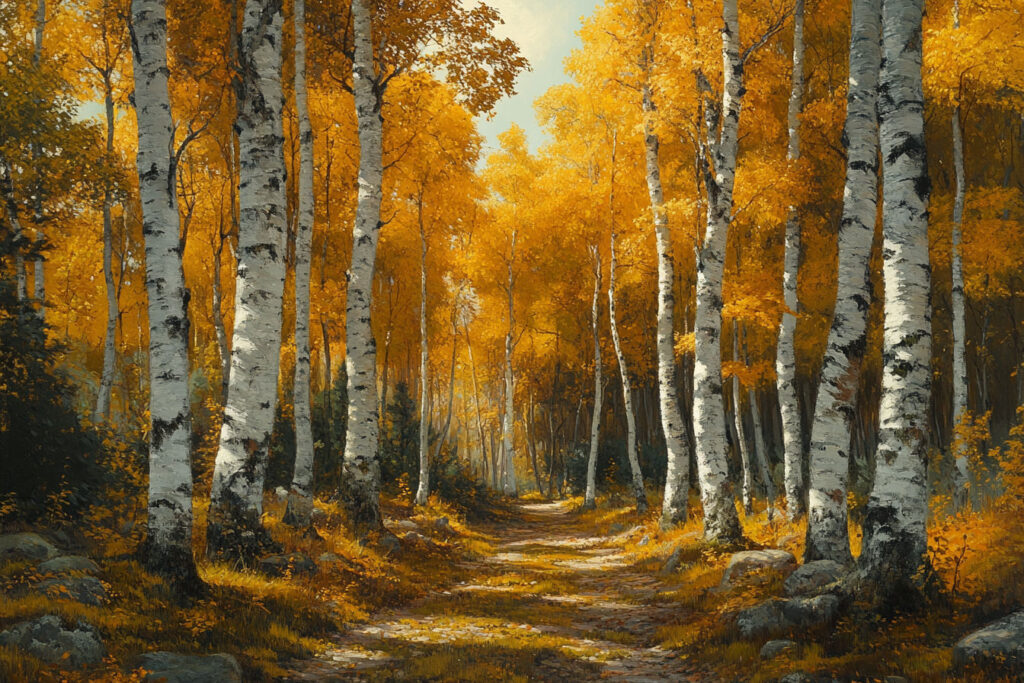
A Bark Like No Other
What sets the Paper Birch apart is its dazzling bark: creamy white, paper-thin, and curling back in delicate strips to reveal warm, cinnamon-hued layers beneath. Indigenous peoples once crafted canoes, containers, and even shoes from this versatile bark—earning it the nickname “Canoe Birch.” As the tree matures, that pristine white may weather to a rugged, textured gray at the base, adding character to its timeless beauty.
Built for the Tough Stuff
This tree laughs in the face of adversity. Poor, rocky soils? No problem. Brutal, bone-chilling winters? Bring it on. The Paper Birch thrives across USDA Zones 2-7, from the frosty forests of Canada to the rolling hills of the northern U.S. It’s a sun-worshipper at heart—give it a spot with full sunlight and well-drained soil, and it’ll reward you with vigorous growth. Soggy roots, though? That’s a hard pass—this birch despises wet feet.
Planting and Care: Easy Does It
Spring is your golden window to plant a Paper Birch. Dig a hole twice as wide as the root ball, settle it in, and water deeply—about an inch a week for the first year to help it establish its roots. After that, this low-maintenance marvel rarely asks for more. Drought? It’ll cope. Fertilizer? Only if the soil’s truly starved. Prune lightly in late winter or early spring to shape its elegant form or remove any wayward branches, but don’t overdo it—those natural curves are part of its charm.
A Four-Season Stunner
In spring, the Paper Birch unfurls bright green, heart-shaped leaves that flutter like confetti in the wind. Come summer, they deepen to a lush emerald, offering dappled shade beneath. Autumn ignites the canopy in a blaze of golden yellow, a fiery farewell to the growing season. And in winter, when the leaves are long gone, that peeling white bark takes center stage, glowing against the stark landscape—a beacon of resilience and grace.
Wildlife and Companions
This tree isn’t just a pretty face—it’s a habitat hero. Birds like chickadees and woodpeckers flock to its branches, while deer might nibble its twigs in leaner months. Pair it with understory stars like ferns, wildflowers, or low shrubs to create a woodland vibe, or let it stand solo as a striking focal point in your yard.
A Word of Caution
The Paper Birch isn’t immortal—expect a lifespan of 40-70 years, shorter if stressed by pests like the bronze birch borer or harsh urban conditions. Keep an eye out for yellowing leaves or dieback, and plant it away from hot pavement or pollution to give it the best shot at a long, happy life.
Why You’ll Love It
Plant a Paper Birch, and you’re not just growing a tree—you’re cultivating a legacy. It’s the kind of centerpiece that sparks conversation, evokes nostalgia, and anchors your landscape with effortless elegance. Whether you’re sipping coffee under its shade or marveling at its snowy silhouette, this birch delivers beauty with a side of grit. Go ahead, give it a home—you won’t regret it.
Coneflower (Echinacea purpurea)
Common Names: Purple Coneflower, Eastern Purple Coneflower
Meet the Coneflower—a perennial powerhouse that’s equal parts beauty and brawn. Rising 2-4 feet tall, this native stunner unfurls its purple, daisy-like blooms from June to August, each flower crowned with a spiky, coppery-orange center that practically begs bees and butterflies to drop by. It’s not just a plant; it’s a pollinator party waiting to happen, and it’s ready to steal the show in your garden.
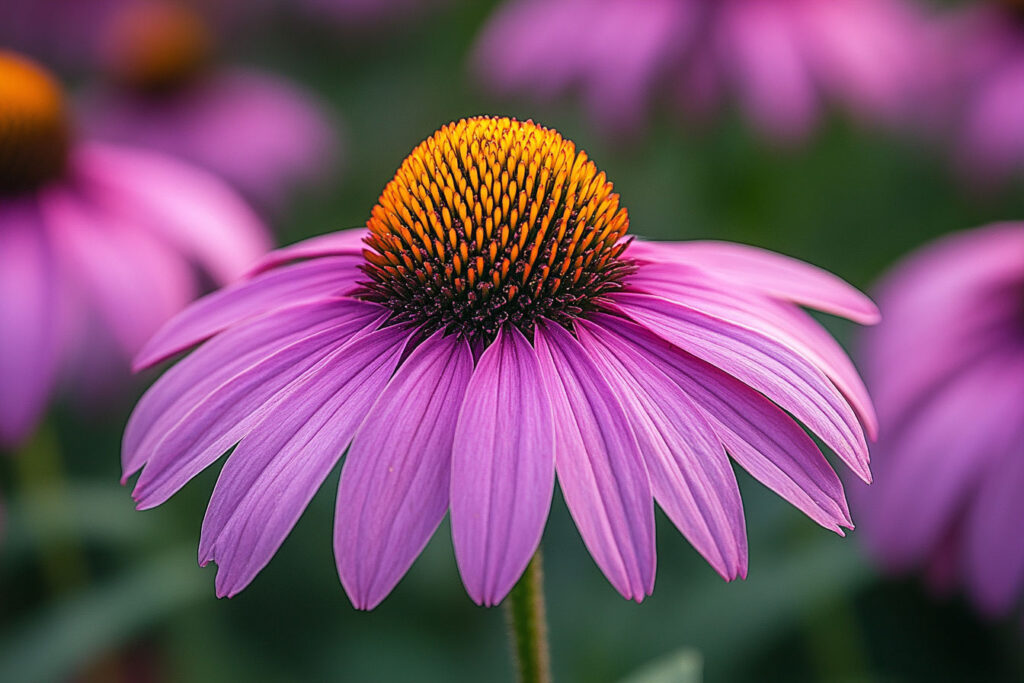
Blooms That Pop
Picture this: broad, rosy-purple petals radiating around a bristly, cone-shaped heart, bobbing atop sturdy stems like nature’s own pom-poms. Those blooms don’t just sit there—they glow in the summer sun, holding court for weeks on end. And while purple is the classic, modern cultivars flirt with pinks, whites, and even fiery oranges, giving you options to play with. Leave them standing into winter, and their faded heads turn into tiny bird buffets—goldfinches will thank you.
Tough as Nails
Coneflowers are the garden equivalent of a roll-up-your-sleeves survivor. Full sun? They thrive on it, soaking up rays in USDA Zones 3-9. Partial shade? They’ll manage. Lean, rocky soil that other plants snub? They’ll dig in and grow anyway. Drought? They shrug it off once established. Just don’t drown them—soggy, waterlogged dirt is their kryptonite. Well-drained soil is the key to keeping this champ happy.
Planting and Care: Low Fuss, Big Payoff
Spring is your cue to get started. Sow seeds directly in the ground after the last frost, or set out nursery starts for a head start—either way, they’re not picky. Water lightly to settle them in, then ease off; an inch a week is plenty until they’re rooted. Once established, they’re practically self-sufficient, bouncing back year after year with zero drama. Want more blooms? Snip off spent flowers (aka deadhead) to coax out a second act. Or skip it and let the seed heads stand tall for winter wildlife—your call.
A Year-Round Player
Summer is the Coneflower’s star turn, with those vibrant blossoms lighting up borders, meadows, or cottage gardens. But don’t sleep on its off-season charm: in spring, its fuzzy green leaves emerge like a promise of what’s to come, and by fall, the dried heads add texture to the fading landscape. Come winter, it’s a rugged silhouette—quiet, stoic, and ready to do it all again next year.
Friends and Neighbors
This plant’s a team player. Pair it with Black-Eyed Susans, bee balm, or ornamental grasses for a prairie-inspired riot of color and texture. Pollinators—bees, butterflies, even hummingbirds—will swarm it, turning your yard into a buzzing hotspot. Plus, it’s deer-resistant (they’ll usually pass it by for tastier treats), making it a win for gardens near woodlands.
Bonus Perks
Beyond its looks, Echinacea purpurea has a storied past—Native Americans used it for centuries as a medicinal herb, brewing teas to soothe colds and aches. Today, it’s still a darling of herbalists, though science debates its punch. Whether you buy into the hype or not, its resilience and charm are undeniable.
Watch Out For
Coneflowers are tough, but not invincible. Overwatering can rot their roots, and crowded spots might invite powdery mildew—good airflow and spacing keep it in check. Pests? Rare, though Japanese beetles might nibble if they’re desperate. Cut back dead stems in late winter to tidy up, and you’re set.
Why It’s a Must-Have
The Coneflower is the garden gift that keeps on giving: bold blooms, easy care, and a knack for making everything around it look better. It’s the friend who shows up on time, brings the vibes, and asks for nothing in return. Plant it once, and you’ve got a perennial pal for years—low effort, high reward. Ready to let it shine in your yard?
Pansy (Viola tricolor)
Common Names: Johnny-Jump-Up, Wild Pansy
Say hello to the Pansy—a pint-sized burst of personality that proves big things come in small packages. Topping out at a modest 6-9 inches, these annuals explode into a riot of yellow, purple, or white blooms, often splashed with cheeky little “faces” that wink at you from spring through early summer. They’re the garden’s cheerful greeters, ready to brighten pots, borders, or window boxes with zero pretension and all the charm.
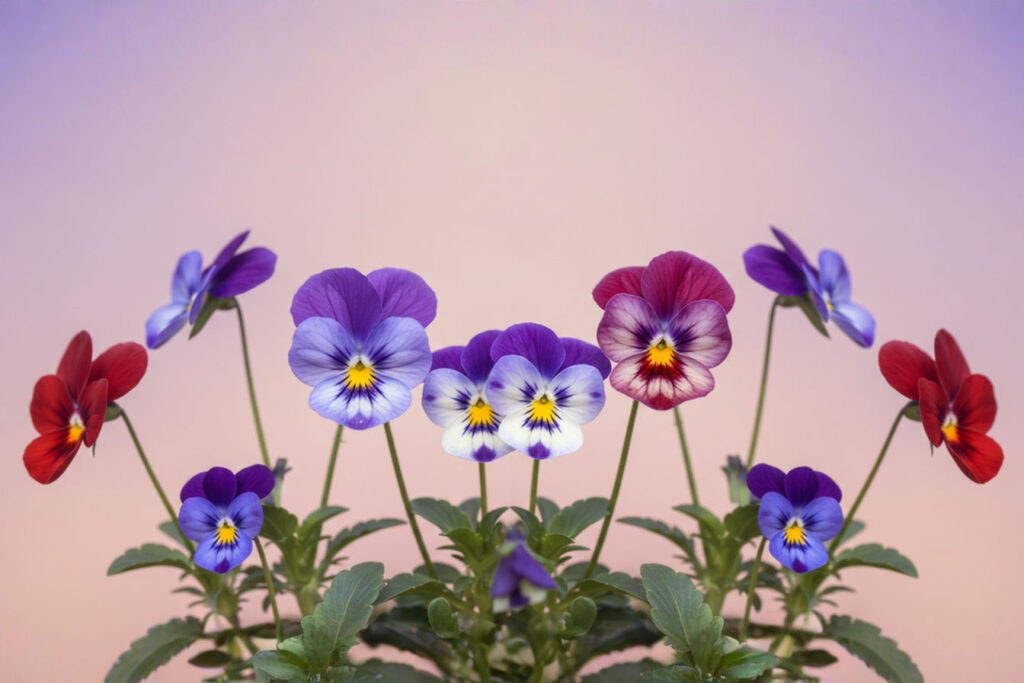
Flowers with Flair
Pansies don’t just bloom—they strut. Each velvety petal unfurls in a kaleidoscope of colors: sunny yellows, royal purples, crisp whites, and sometimes a flirty mix of all three, accented by dark, whisker-like markings that give them their signature “face.” These aren’t shy wallflowers; they’re bold, five-petaled show-offs that keep the party going for weeks. And here’s a fun twist: they’re edible! Toss a few into salads or desserts for a pop of color and a mild, minty zing.
Happy Anywhere
Pansies are the Goldilocks of the plant world—not too picky, just right. They soak up full sun like champs but won’t sulk in light shade, making them perfect for that tricky spot where light dances between beams and shadows. Give them rich, moist soil that drains well (think fluffy loam, not swampy muck), and space them 6 inches apart so they can stretch out. They’ll thrive across USDA Zones 4-8, shrugging off light frosts with a sassy resilience that’ll make you smile.
Planting and Care: Keep It Simple
Spring or fall is prime time to plant these darlings—set out nursery starts or sow seeds in early spring for a quick payoff. Water steadily, aiming for damp but never soggy; puddles are their sworn enemy. A little liquid fertilizer every few weeks keeps them perky, but don’t overdo it—they’re not greedy. Pinch off faded blooms to spur more flowers, or let them drop seeds for a surprise encore next season. When summer heat or winter cold finally knocks them out, swap them for fresh faces or wait for their self-sown comeback.
Seasons of Joy
Pansies peak in spring and early summer, painting the landscape with cool-toned cheer when everything else is just waking up. In milder climates, they’ll even bloom into fall or winter, defying the chill with pluck. Their low, mounding habit makes them ideal for edging paths, spilling over containers, or carpeting bare spots with color. Pair them with tulips, snapdragons, or violas for a layered look that screams cottage-core charm.
Wildlife and Whimsy
Bees and butterflies give them a friendly nod, though they’re not the pollinator magnet some plants are—pansies are more about stealing your heart than hosting a bug bash. Deer tend to skip them, too, which is a bonus if Bambi’s a regular in your yard. And here’s a quirky tidbit: in Victorian times, pansies symbolized secret love, their “heartsease” nickname a nod to their soothing vibes.
Heads-Up
Pansies aren’t divas, but they’ve got limits. Overwatering invites root rot, and cramped quarters can breed mildew—keep the air flowing and the soil balanced. Summer scorch can wilt them in hotter zones, so plan for shade or a seasonal swap when the sun turns brutal. Slugs might nibble, but a sprinkle of grit or a beer trap keeps them at bay.
Why They’re a Win
Pansies are the garden’s little mood-lifters—easy to grow, eager to please, and packed with old-school charm. They’re the floral equivalent of a handwritten note: simple, sweet, and straight to the heart. Plant them once, and you’ll be hooked on their pluck and playfulness. Ready to let these cuties jump into your life?
Beginner Tip: Start with hardy natives like these to build confidence in tough climates. They’re forgiving, letting you learn as you grow, even when winter bites hard.
Temperate Zones (5-7) – Versatile Picks for Moderate Weather
Zones 5-7 stretch across the U.S. heartland, from the Midwest to the Pacific Northwest, with average minimum winter temperatures ranging from -20°F to 0°F. These areas enjoy balanced seasons—cold, snowy winters and warm, humid summers—with growing periods of 150-180 days. Moderate conditions open the door to diverse, easy-care plants for beginners.
New gardeners shine in these zones with adaptable, low-effort options. Try Black-Eyed Susan, Lavender, and Daylily to fill your yard with color and fragrance without the stress.
Black-Eyed Susan (Rudbeckia hirta)
Common Names: Gloriosa Daisy
Step aside, wallflowers—here comes the Black-Eyed Susan, a perennial powerhouse that brings sunshine to any garden. Stretching 2-3 feet tall, this native beauty erupts in golden-yellow blooms from June to September, each flower flaunting a bold, chocolate-brown center like a bullseye begging for attention. It’s a butterfly magnet, a drought-defying champ, and a burst of cheer that’ll make your landscape sing, especially in the heart of Zones 5-7.

A Golden Glow
Picture a sea of daisy-like flowers, their petals a radiant yellow that practically hums with summer energy, circling dark, velvety domes that give them their “black-eyed” swagger. These blooms don’t just show up—they dominate, lasting weeks on end and popping against fuzzy green leaves. While technically a short-lived perennial (or even a biennial in some spots), they reseed like champs, ensuring their sunny legacy year after year.
Built for the Grind
Black-Eyed Susans are the tough cookies of the plant world. They crave full sun—six hours or more—and revel in well-drained soil, from sandy loams to clay-heavy patches, as long as water doesn’t linger. Once their roots dig in, they laugh off drought, heat, and even the occasional neglect, thriving across Zones 5-7’s chilly winters and humid summers. Poor soil? They’ll still shine, though a little organic matter doesn’t hurt their vibe.
Planting and Care: Set It and Forget It
Spring is your sweet spot—plant nursery starts or sow seeds after the last frost, spacing clumps 18 inches apart to give them room to strut. Water weekly (about an inch) until they’re settled, then ease off; these gals don’t need coddling. Deadhead spent blooms to keep the flower train rolling into fall, or let the seed heads stand tall for a winter buffet—finches and sparrows will swoop in for the snack. Cut them back in late fall or early spring to tidy up, and watch them rebound with gusto.
Seasons of Swagger
June kicks off the show, with blooms unfurling just as the garden hits its stride. By midsummer, they’re a golden wave, lighting up meadows, borders, or wildflower patches. Come September, they’re still going strong, bridging the gap to autumn with flair. In winter, their dried stalks and bristly heads add rugged texture—proof they’re in it for the long haul. Pair them with coneflowers, bee balm, or grasses for a prairie-party vibe that screams Zones 5-7 charm.
Wildlife Welcome Wagon
Butterflies—monarchs, swallowtails, you name it—flock to these nectar-rich blooms, turning your yard into a winged wonderland. Bees buzz in for the pollen, and when the flowers fade, birds swoop down for the seeds. Deer? They’ll usually pass, making Black-Eyed Susans a solid pick for rural gardens. Plus, they’re pest-resistant—rarely bothered by bugs or disease beyond a little mildew if airflow’s tight.
Roots and Reputation
Native to North America’s prairies and plains, Rudbeckia hirta carries a wildflower soul with a cultivated edge. It’s named for Olaus Rudbeck, a Swedish botanist, but its real fame comes from its starring role in folklore and state pride—Maryland crowned it the official flower in 1918. Today, it’s a go-to for gardeners who want tough-as-nails beauty without the fuss.
Watch Out For
These plants are low-drama, but overwatering can sog their roots, and crowding might invite powdery mildew—space them out and keep the soil on the dry side. In richer dirt, they might flop, so skip the heavy fertilizer unless they’re starving. If they start to fade after a few years, divide clumps in spring to refresh their vigor.
Why It’s a Keeper
Black-Eyed Susans are the garden’s MVPs: bold, reliable, and bursting with heart. They bring color that lasts, wildlife that delights, and a no-nonsense attitude that fits Zones 5-7 like a glove. Plant them once, and you’ve got a cheerful winner that keeps coming back—whether you’re a green thumb or a laissez-faire grower. Ready to let these golden gals light up your life?
Lavender (Lavandula angustifolia)
Common Names: English Lavender
Prepare to be seduced by Lavender—a fragrant, silvery stunner that turns any garden into a sensory escape. Growing a tidy 1-2 feet tall, this evergreen herb unfurls spikes of purple blooms in summer, each whorl releasing a perfume that drifts on the breeze like a whispered promise. It’s not just a plant; it’s a mood, a vibe, and a gift to your senses, thriving beautifully in Zones 5-7.
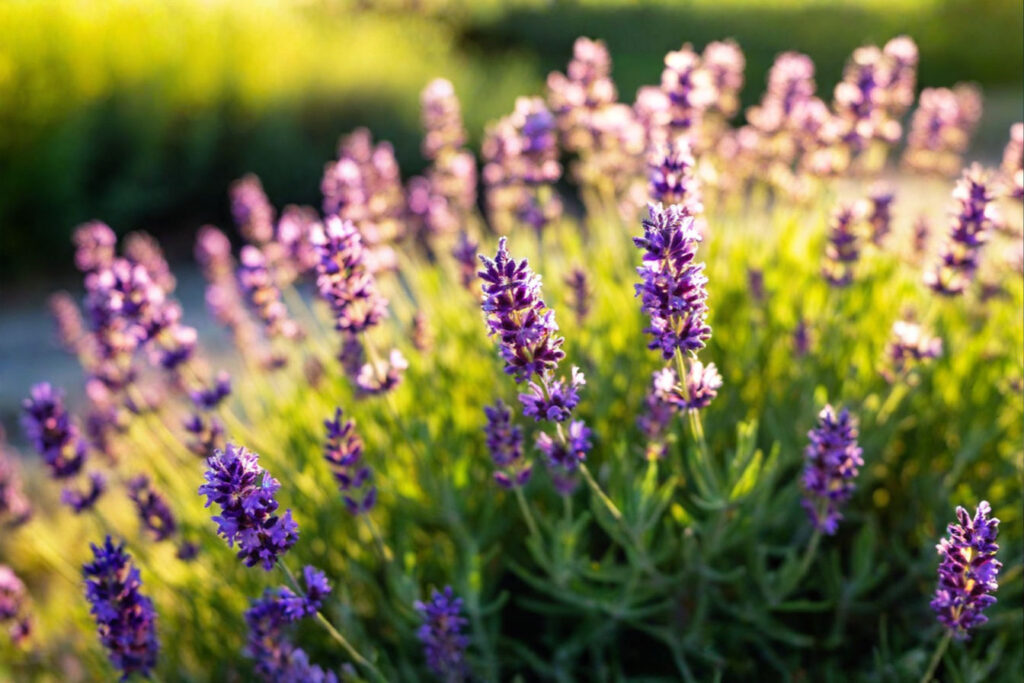
A Feast for the Eyes and Nose
Imagine this: slender, gray-green leaves shimmer like brushed silver, crowned by wands of deep purple flowers that dance in the sunlight from June to August. That scent—sweet, floral, with a hint of earthy spice—wafts through the air, calming your mind and conjuring images of Provence’s rolling hills. Snip a stem, and the fragrance lingers on your fingers; let it bloom, and it’s a beacon for bees and butterflies. Bonus: those blooms dry beautifully for sachets, crafts, or a sprinkle in your tea.
Sun-Drenched and Carefree
Lavender’s a sun junkie—give it full exposure (six hours minimum) and watch it thrive. It’s picky about soil, though: dry, sandy, or rocky is its jam, with sharp drainage a must. Wet feet? A death sentence. This Mediterranean native shrugs off drought like a champ, making it the patron saint of forgetful waterers in Zones 5-7’s variable climates. Poor soil? It’ll still strut its stuff, as long as it’s not rich or soggy.
Planting and Care: Less Is More
Spring’s your window—set plants or rooted cuttings 12-18 inches apart in well-drained beds or pots, giving them space to breathe. Water lightly for the first month to settle the roots (an inch a week), then back off—overwatering is the enemy. Once established, it’s practically self-sufficient, sipping only what the sky provides. Prune lightly after blooming to keep it bushy, or shear it back by a third in early spring to refresh its form. Cold snaps down to -10°F? It’ll soldier through, especially with a mulch blanket in harsher Zone 5 winters.
Seasons of Serenity
Summer is Lavender’s peak, with those aromatic spikes stealing the show in rock gardens, borders, or herb patches. Spring brings fresh, soft growth, while fall fades the blooms but leaves the foliage glowing. In winter, its evergreen silhouette holds quiet elegance against frost or snow—a subtle reminder of warmer days to come. Pair it with rosemary, thyme, or Black-Eyed Susans for a drought-tolerant dream team that sings in Zones 5-7.
Buzz and Benefits
Bees go wild for Lavender’s nectar, turning your yard into a humming haven, while butterflies add a flutter of grace. Deer and rabbits? They’ll sniff and move on—its scent repels them naturally. In the kitchen, those blooms perk up baked goods, teas, or even a fancy lemonade. Historically, it’s been a healer’s ally—used for centuries to ease stress, headaches, and sleepless nights. Science backs some of that hype, but honestly, just smelling it is therapy enough.
Heads-Up
Lavender’s low-maintenance, but it’s not immortal. Heavy clay or soggy spots rot its roots—amend with grit or gravel if your soil’s dense. Too much shade stretches it thin, and over-fertilizing makes it floppy and bloom-shy—skip the food unless it’s desperate. In Zone 5, pick hardy cultivars like ‘Munstead’ or ‘Hidcote’ for extra winter grit, and shelter pots from brutal freezes.
Why You’ll Fall For It
Lavender’s the total package: beauty, fragrance, and a laid-back attitude that fits Zones 5-7 like a glove. It’s the plant that asks for little and gives back tenfold—whether you’re harvesting its blooms, feeding the bees, or just basking in its glow. Plant it once, and you’ve got a slice of serenity that doubles as a conversation starter. Ready to let this purple powerhouse weave its magic in your world?
Daylily (Hemerocallis spp.)
Common Names: Ditch Lily (for some wild types)
Say hello to the Daylily—a perennial rockstar that proves you don’t need fuss to deliver dazzle. Rising 1-3 feet tall, these champs churn out trumpet-shaped blooms in a fiery palette of orange, yellow, or red from late spring to mid-summer, each flower a one-day wonder that keeps the show rolling. Adaptable, tough, and bursting with color, they’re a garden staple that shines in Zones 5-7 with minimal TLC.
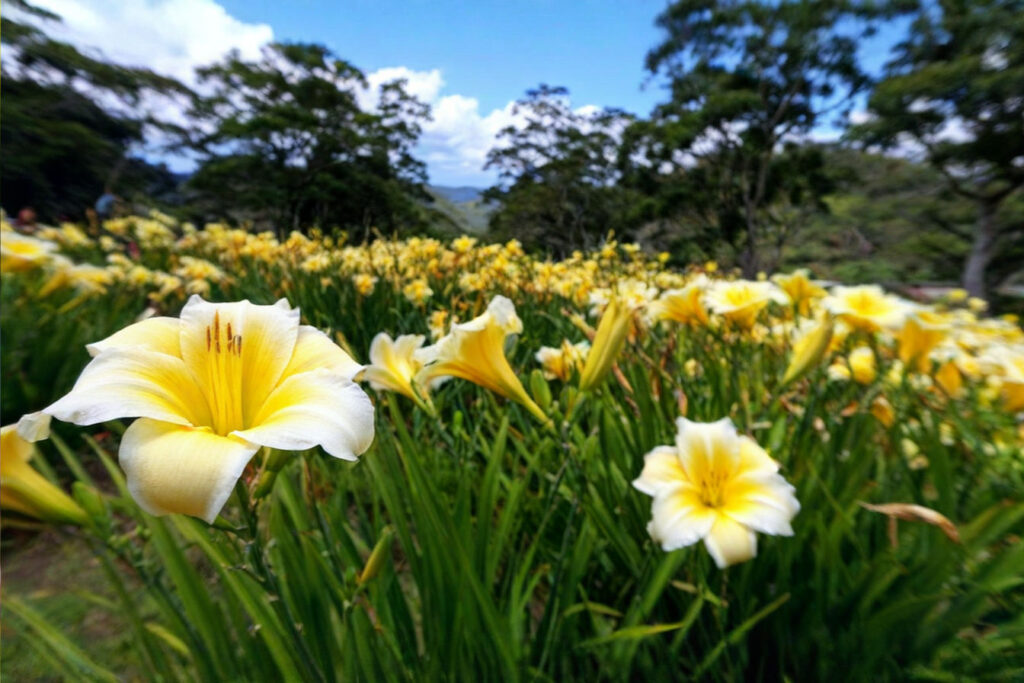
Blooms That Steal the Spotlight
Picture this: bold, lily-like flowers unfurl atop slender stems, their petals curling back like trumpets heralding summer’s arrival. Orange is the classic—think roadside wildflowers glowing at dusk—while yellows range from buttery soft to lemon-bright, and reds smolder like embers. Each bloom lasts just a day (hence the name), but don’t worry—there’s a parade of buds waiting in the wings, keeping the display alive for weeks. Modern hybrids even toss in pinks, purples, and doubles for extra flair.
Go-With-the-Flow Vibes
Daylilies are the chill friends of the plant world. Full sun? They’ll soak it up and bloom like mad. Partial shade? They’ll still perform, just with a slightly softer glow. Soil? They’re not snobs—loam, sand, or clay works fine, as long as it drains decently. Once their roots are cozy, they shrug off drought, thriving in Zones 5-7’s hot summers and cold winters with barely a whimper. Overwater them, though, and they’ll sulk—less is more here.
Planting and Care: Easy Peasy
Spring or fall is your cue—plant them when the ground’s workable, spacing clumps 18-24 inches apart to let their grassy foliage fan out. Dig a hole, pop in the roots (crown just at soil level), and water moderately for a few weeks to settle them in—about an inch weekly. After that, they’re low-maintenance champs; rain’s usually enough unless it’s a desert summer. Snip off spent blooms to keep things neat, and every 3-5 years, divide overcrowded clumps in spring or fall to reboot their vigor. A quick chop of dead leaves in late fall, and they’re set.
Year-Round Resilience
Late spring ignites the bloom-fest, peaking through July in Zones 5-7, with some varieties stretching into August. Their strap-like leaves—green or golden, depending on the type—form lush mounds that double as groundcover. Post-bloom, the foliage hangs tough, evergreen in milder spots or dying back gracefully in colder winters, only to roar back come spring. Pair them with hostas, lavender, or coneflowers for a textural riot that plays nice all season.
Garden Party Guests
Butterflies and hummingbirds swoop in for the nectar, though daylilies aren’t the bee bonanza some plants are—each flower’s brevity keeps the pollinator RSVP list short. Deer might nibble tender shoots, but they’re not a favorite snack, especially with tastier options around. Fun fact: the buds and blooms are edible—toss them in stir-fries or salads for a crisp, mild bite (just skip wild ones near roads).
Roots and Rep
Hemerocallis means “beauty for a day” in Greek, but don’t let that fool you—these plants are in it for the long haul. Native to Asia, they’ve conquered gardens worldwide, from ancient Chinese cuisine to modern American yards. In Zones 5-7, they’re a no-brainer—tough enough for neglect, pretty enough for pride of place.
Watch Out For
Daylilies are laid-back, but soggy soil can rot their roots—drainage is key. Rust or leaf streak might pop up in humid summers; snip affected parts and space them out for airflow. If blooms dwindle, it’s time to divide—crowding saps their mojo. And watch those sneaky seedlings; some types spread like gossip in a small town.
Why They’re a Slam Dunk
Daylilies are the garden’s MVPs: vibrant, versatile, and virtually indestructible. They bring color that pops, foliage that fills, and a can-do spirit that fits Zones 5-7 like a glove. Plant them once, and you’ve got a reliable burst of joy that keeps delivering—whether you’re a hands-on gardener or a laissez-faire fan. Ready to let these trumpets blow you away?
Beginner Tip: Mulch around these plants with 2-3 inches of wood chips or straw. It shields roots from winter cold and summer heat, cutting your maintenance time in half.
Warm Zones (8-10) – Heat-Loving Plants for Long Seasons
Zones 8-10 sweep across the southern U.S., from coastal California to the Carolinas, with average minimum winter temperatures between 10°F and 30°F. Mild winters mean rare frosts, while long, hot summers stretch growing seasons to 200-300 days. High heat and occasional drought call for plants that soak up sunshine and sip water wisely.
Beginners flourish in these warm zones with tough, vibrant choices. Rosemary, Marigold, and Crepe Myrtle deliver flavor, color, and structure with little upkeep.
Rosemary (Rosmarinus officinalis)
Common Names: Dew of the Sea, Herb of Remembrance
Meet Rosemary—a rugged, aromatic evergreen that’s the unsung hero of Zones 8-10. Growing 2-4 feet tall (sometimes more if it’s feeling frisky), this shrub rocks needle-like leaves and sprinkles of tiny blue flowers in spring or summer, filling the air with a piney, herbaceous scent. It’s a Mediterranean marvel that shrugs off heat, thrives on neglect, and doubles as a kitchen MVP—perfect for warm-climate gardeners who want flavor with zero drama.
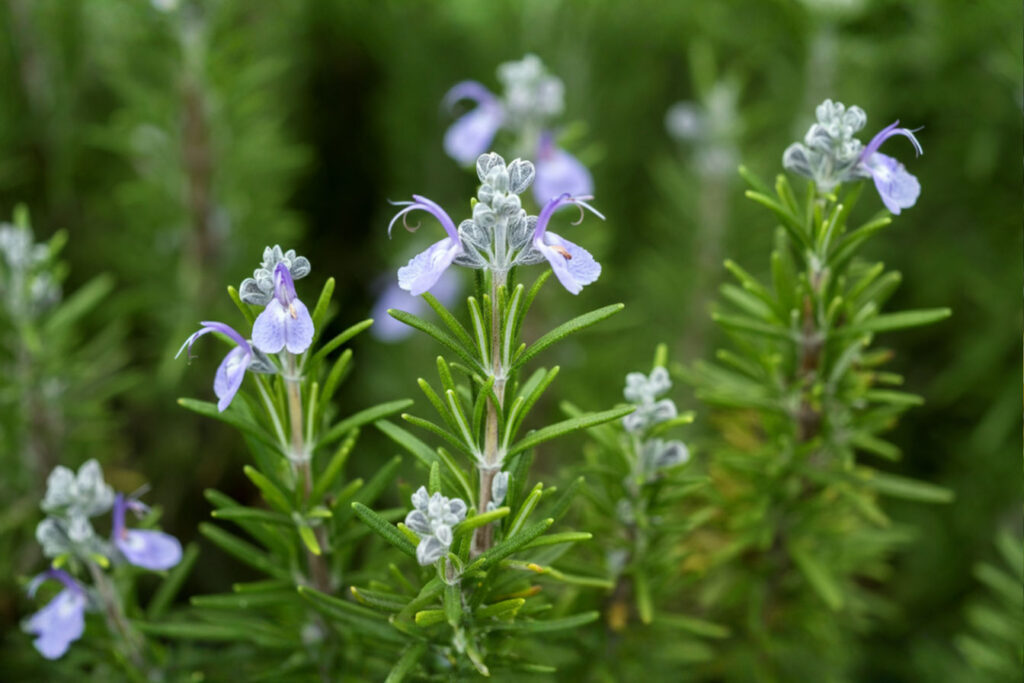
A Fragrant Flair
Imagine silvery-green needles, stiff and spiky, brushing your fingers with a whiff of resin and earth—pure sensory magic. Come spring or summer (sometimes even winter in Zone 10’s mild stretches), it tosses out clusters of delicate blue blooms—pale as a coastal sky—that hum with bees. The foliage is the real star, though, evergreen and tough, turning any brush past it into an instant aromatherapy session. Snip a sprig, and your kitchen’s about to level up.
Heat-Hardy and Happy
Rosemary’s a sun-chaser—full exposure (six hours or more) is its fuel, and it basks in the dry, blazing warmth of Zones 8-10, from Texas hills to California coasts. Well-drained soil is non-negotiable—sandy, rocky, or lean is ideal; it’ll scoff at rich muck or soggy roots. Once established, it’s a drought-defying champ, sipping sparingly in the arid summers that wilt fussier plants. Poor dirt? It’ll still strut, making it a low-maintenance gem for warm-zone yards.
Planting and Care: Less Is Best
Spring’s your moment—plant it when the soil’s workable, spacing bushes 2-3 feet apart to let them sprawl or stand tall. Dig a hole, mix in grit if your dirt’s heavy, and water deeply—an inch or two—to settle the roots. For the first month, keep it moist but not soaked; after that, taper to a deep drink every 10 days (less if rains pitch in). Prune lightly anytime to shape it—clip for cooking or shear for a tidy hedge—but don’t overdo it; its wild vibe is the charm. Skip the fertilizer unless it’s starving; lean living keeps it blooming.
Seasons of Sizzle
In Zones 8-10, Rosemary’s a year-round player. Spring and summer spark those blue flowers, while the foliage holds strong through fall and winter—evergreen even when Zone 8 flirts with frost. It’s versatile: let it mound as a groundcover, train it upright as a mini tree, or line it up for a fragrant border. Pair it with lavender, marigolds, or crepe myrtle for a drought-tolerant crew that owns warm climates.
Buzz and Benefits
Bees adore the blooms, turning your patch into a low-key pollinator pitstop, while butterflies might flutter by. Deer and rabbits? They’ll pass—the scent’s too sharp for their tastes. In the kitchen, it’s gold—roast it with potatoes, infuse it in oil, or toss it on the grill for a smoky kick. Historically, it’s the “herb of remembrance”—Romans and Greeks wore it for focus, and modern studies hint it might sharpen your mind. Smell it and believe it.
Roots and Rep
Native to the Mediterranean, Rosemary’s name—“dew of the sea”—nods to its coastal roots, where it clings to cliffs and thrives on salt spray. In Zones 8-10, it’s a natural fit, echoing that rugged resilience in warm, dry gardens. Cultivars like ‘Tuscan Blue’ go upright, while ‘Prostratus’ creeps low—pick your style.
Watch Out For
Rosemary’s chill, but wet feet rot it—drainage is life. Too much shade or water cuts its blooms and saps its spirit; sun and dry are the mantra. Powdery mildew might sneak in humid pockets—space it out for airflow. In Zone 8’s rare hard freezes, mulch or shelter tender plants, though it usually toughs it out above 20°F.
Why It’s a Warm-Zone Win
Rosemary’s the total package in Zones 8-10: scent, style, and a no-fuss attitude that laughs at heat and drought. It’s a fragrant workhorse—snip it, smell it, cook it, or just let it shine—and it’ll keep your garden buzzing with life. Plant it once, and you’ve got a perennial pal that delivers flavor and flair. Ready to let this herb rock your world?
Marigold (Tagetes spp.)
Common Names: French Marigold, African Marigold, Mexican Marigold
Get ready for a fiesta of color with Marigolds—the annuals that bring the heat to Zones 8-10. Ranging from a petite 6 inches to a bold 36 inches, depending on the variety, these sun-worshippers ignite gardens with fiery orange, sunny yellow, or rich red blooms from spring straight through fall. They’re not just pretty faces—they’re pest-repelling powerhouses, lighting up your yard with a glow that lasts all season long.
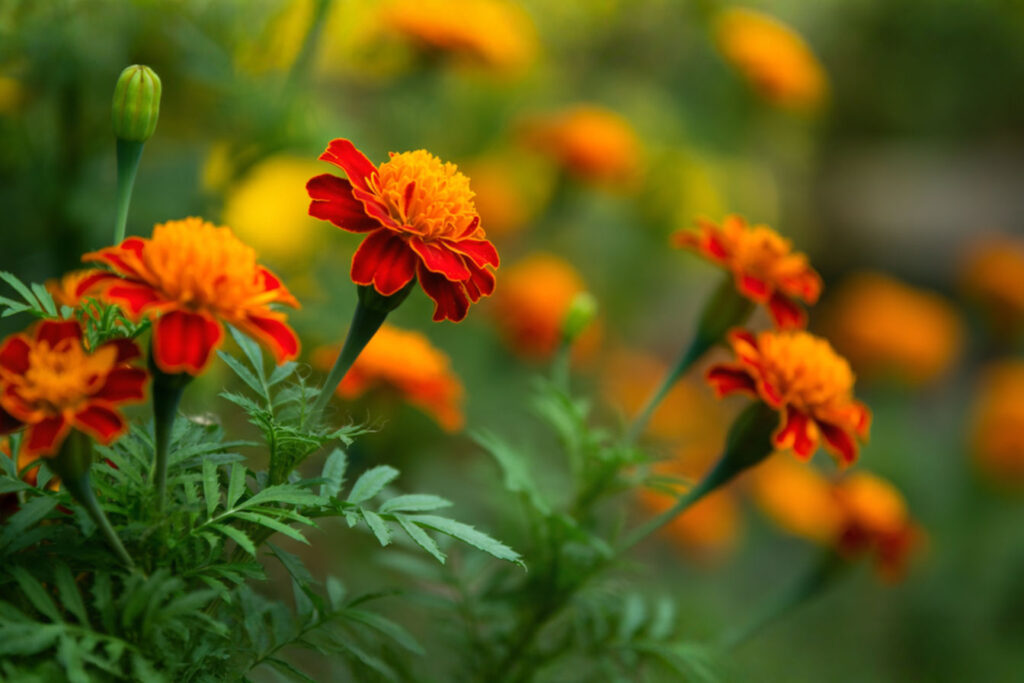
A Burst of Brilliance
Imagine pom-poms of pure sunshine: Marigolds deliver ruffled, daisy-like flowers that range from dainty singles to plush doubles, depending on whether you pick French (Tagetes patula), African (Tagetes erecta), or another type. Their colors pop—think traffic-cone orange, lemon-drop yellow, or a red that smolders like a desert sunset. That spicy, earthy scent? It’s their secret weapon, wafting through the air and telling pests like nematodes and aphids to buzz off. In Zones 8-10’s long growing season, they’re relentless—blooming until the first frost dares to show up.
Tough and Tolerant
Marigolds are the gritty survivors of the flower world. Full sun is their happy place—six hours or more—and they’ll thrive in the scorching heat of Zones 8-10, from California’s coast to Texas’s plains. Soil? They’re not fussy. Sandy, rocky, or just plain poor—they’ll take it and run, as long as it drains. Rich dirt works too, but don’t overdo the water; soggy roots make them pout. Drought? They’ll soldier on, making them perfect for warm-climate gardeners who’d rather sip iced tea than fuss with a hose.
Planting and Care: Low Effort, High Reward
Spring’s your green light—sow seeds directly after the last frost (they sprout fast in warm soil) or set out nursery starts, spacing them 6-12 inches apart depending on size (closer for dwarfs, wider for giants). Water weekly—an inch or so—until they’re rooted, then ease off; they’ll sip sparingly once established. Pinch or snip off faded blooms to keep the flower factory humming—deadheading fuels their nonstop show. In Zones 8-10’s mild winters, you might even coax a second round with a late-summer planting.
Seasons of Sizzle
From spring’s first flush to fall’s grand finale, Marigolds keep the party going in warm zones. French types mound low and bushy—perfect for edging or pots—while African giants tower tall, staking a claim in borders or beds. Their ferny, green foliage adds texture year-round, and in frost-free pockets of Zone 10, they might just cheat winter altogether. Pair them with zinnias, cosmos, or salvia for a hot-hued explosion that screams summer in the South or Southwest.
Garden Guardians
Marigolds don’t just look good—they work hard. Their roots release compounds that fend off soil-dwelling nematodes, earning them a rep as companion plants for veggies like tomatoes or peppers. Butterflies and bees drop by for a sip, though the scent keeps bigger pests—like whiteflies—at bay. Deer and rabbits? They’ll wrinkle their noses and move on. Bonus: those petals are edible—sprinkle them on salads or cakes for a peppery kick and a splash of color.
Roots and Rituals
Native to Mexico and Central America, Marigolds (or “cempasúchil” in Nahuatl) star in Día de los Muertos celebrations, their vibrant hues said to guide spirits home. Today, they’re a global garden staple, beloved for their grit and glow. In Zones 8-10, they’re right at home, basking in the warmth they were born for.
Watch Out For
Marigolds are easygoing, but overwatering invites root rot—keep it light. Too much shade or rich soil can make them leggy and bloom-shy; sun and lean ground are their sweet spot. Spider mites might crash the party in dry heat—blast them with a hose if they dare. When frost finally hits (if it does), they’ll bow out—replant and repeat.
Why They’re a Hot Pick
Marigolds are the warm-zone MVP: bold, bright, and built for the long haul in Zones 8-10. They pump out color, protect your patch, and ask for little more than a sunny spot to shine. Plant them once, and you’ve got a season-long celebration—whether you’re a green-thumb guru or a laid-back grower. Ready to let these fiery friends spice up your garden?
Crepe Myrtle (Lagerstroemia indica)
Common Names: Crapemyrtle, Southern Lilac
Meet the Crepe Myrtle—a small tree or shrub that’s the South’s summer darling, lighting up Zones 8-10 with flair. Stretching anywhere from 6 to 25 feet tall (depending on the cultivar), it unleashes a fireworks show of pink, purple, or white flower clusters from June to August, then struts into fall with a blaze of color. Heat? Humidity? Bring it on—this beauty thrives where others wilt, delivering drama with a side of easygoing charm.
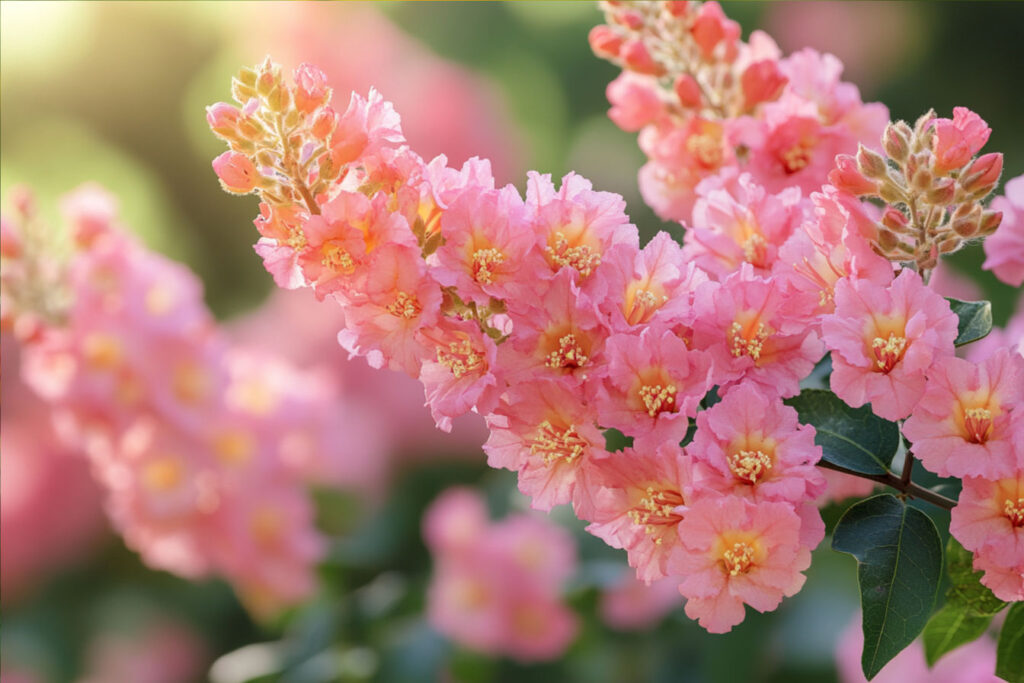
A Blooming Spectacle
Imagine crinkly, crepe-paper-like blooms bursting forth in dense, frothy panicles—pink as cotton candy, purple like a twilight sky, or white with a pristine glow. They cascade from the tips of branches, turning heads all summer long in Zones 8-10’s sultry climate. When autumn rolls in, the leaves shift to fiery reds, oranges, or yellows, while the smooth, mottled bark—peeling in cinnamon and gray patches—adds year-round intrigue. It’s a four-season knockout, even shedding gracefully in milder winters.
Heat-Loving Hustler
Crepe Myrtle is the poster child for tough love. It demands full sun—six hours or bust—and laughs off the blistering heat and sticky humidity of Zones 8-10, from Georgia’s lowlands to Arizona’s deserts. Soil? Well-drained is the ticket; it’ll handle sand, loam, or clay as long as water doesn’t pool. Drought-tolerant once established, it’s a dream for warm-zone gardeners who’d rather admire than pamper. Poor dirt won’t faze it, though a little compost at planting gives it a boost.
Planting and Care: Set It Up Right
Spring or fall is prime time—plant it when the weather’s mild, spacing specimens 8-10 feet apart (or closer for hedges, wider for trees). Dig a hole twice as wide as the root ball, settle it in, and water regularly—about an inch a week—for the first year to root it deep. After that, it’s a low-maintenance star; rainfall often suffices unless drought hits hard. Prune lightly in late winter or early spring to shape it—snip suckers and crossing branches, but don’t “crepe murder” it with heavy chops; those elegant lines are its soul. A sprinkle of balanced fertilizer in spring keeps it happy, but it’s not needy.
Seasons of Swagger
Summer is the Crepe Myrtle’s main event, with blooms exploding just as Zones 8-10 hit peak sizzle. Fall follows with a leafy encore—vibrant hues that rival maples up north. Winter strips it bare, revealing that stunning, exfoliating bark—a sculptural treat against gray skies or rare frost. Come spring, fresh green shoots signal the cycle’s restart. Plant it solo as a focal point, line it up for a flowering screen, or mix it with marigolds or salvia for a warm-zone wonderland.
Wildlife and Wow Factor
Butterflies and bees swarm the nectar-rich blooms, turning your yard into a buzzing hotspot, while hummingbirds might dart in for a sip. Deer usually pass it by—too tough for their taste—and pests like aphids or powdery mildew rarely crash the party if air flows free. That bark? It’s a conversation starter, peeling away to reveal a mosaic that glows in the low sun of Zones 8-10’s mild winters.
Roots and Rep
Hailing from Asia, Crepe Myrtle found its true home in the American South, earning the nickname “Southern Lilac” for its lush blooms and adaptability. In Zones 8-10, it’s a landscaping legend—gracing streets, yards, and patios with effortless grace. Dwarf varieties (like ‘Pocomoke’) fit small spaces, while giants (like ‘Natchez’) command bigger stages.
Watch Out For
Crepe Myrtle’s a trooper, but soggy soil spells doom—drainage is non-negotiable. Overpruning turns it into a lollipop mess; keep cuts minimal for natural beauty. In shadier spots, blooms thin out—sun’s the fuel here. Powdery mildew might dust older types in humid summers—pick resistant cultivars like ‘Muskogee’ or ‘Tuscarora’ to dodge it.
Why It’s a Warm-Zone Winner
Crepe Myrtle is the MVP of Zones 8-10: bold blooms, killer bark, and a heatproof attitude that shrugs off the toughest summers. It’s low-fuss glamour—plant it, shape it, and let it shine. Whether you’re sipping sweet tea on the porch or hosting a backyard bash, this stunner delivers a show that lasts. Ready to let it strut its stuff in your garden?
Beginner Tip: Water these plants deeply but infrequently—aim for once a week after they’re established. It mimics their natural rhythm, saving you time and keeping them happy.
Tropical Zones (11-13) – Lush Choices for Year-Round Growth
Zones 11-13 hug the U.S.’s southern edges—think Hawaii, south Florida, and coastal Puerto Rico—with average minimum temperatures above 40°F. Frost never visits, and year-round heat and humidity fuel growing seasons that don’t quit. High rainfall and intense sun demand plants that handle moisture and blaze without burning out.
Beginners revel in these tropical zones with bold, easy growers. Hibiscus, Bougainvillea, and Elephant Ear turn your yard into a paradise with minimal effort.
Hibiscus (Hibiscus rosa-sinensis)
Common Names: Hawaiian Hibiscus, Rose Mallow, Chinese Hibiscus
Say aloha to the Hibiscus—a tropical showstopper that turns Zones 11-13 into a paradise of color. This evergreen shrub stretches 4-10 feet tall, unleashing massive, trumpet-shaped blooms in red, pink, or yellow from spring clear through fall. It’s the floral equivalent of a beach party—bold, beautiful, and basking in the heat of places like South Florida, Hawaii, or coastal SoCal. One look, and you’re hooked.

Blooms That Wow
Picture flowers the size of your hand—up to 6 inches wide—flaring open like tropical fireworks. Scarlet reds smolder with intensity, soft pinks blush like a sunset, and yellows gleam like midday sun, often with a contrasting throat that draws the eye. Each bloom lasts a day or two, but this shrub’s a bloom machine, pumping out fresh ones nonstop in the endless summers of Zones 11-13. Glossy, dark green leaves frame the show, giving it a lush, jungle vibe even when flowers take a brief breather.
Heat-Seeking Heaven
Hibiscus is built for the tropics—it craves full sun (six hours or more) and drinks in the steamy warmth of Zones 11-13 like a pro. Rich, well-drained soil is its sweet spot—think loamy goodness with a touch of organic matter—but it’ll adapt to sand or clay if water moves through. Heat and humidity? It thrives on them, laughing off the sultry conditions that wilt lesser plants. Dry spells? It’ll cope, but it prefers a steady sip to keep its bloom game strong.
Planting and Care: Tropical Ease
Spring’s your go-time—plant it when the soil’s warm, spacing shrubs 3-6 feet apart (closer for hedges, wider for standalone stunners). Dig a hole twice the root ball’s width, mix in compost, and water deeply—about an inch weekly, more if the tropical sun bakes the soil dry fast. Once settled, it’s low-fuss; keep it moist but not soggy. Pinch or snip faded blooms to spark new buds, or let it run wild for a dense, flowering screen that screams island life. A dose of balanced fertilizer monthly in the growing season keeps it lush—think of it as a piña colada for your plant.
Year-Round Radiance
In Zones 11-13, Hibiscus doesn’t know the meaning of “off-season.” Spring kicks off the bloom bonanza, peaking through summer and fall with a relentless floral parade. Even in the mild “winters” of these tropics, it keeps going—less intense, maybe, but still dazzling. Its bushy form makes it a natural for hedges, patio pots, or a solo statement piece. Pair it with bougainvillea, bird of paradise, or palms for a tropical tapestry that never quits.
Wildlife and Wow
Hummingbirds and butterflies can’t resist the nectar, turning your garden into a buzzing, fluttering hotspot. Bees join the party, too, while the occasional lizard might sunbathe on its branches. Deer? Not a fan—too exotic for their taste. And here’s a perk: those petals are edible—brew them into a tart, ruby-red tea (hello, hibiscus agua fresca) or float them in a cocktail for instant island cred.
Roots and Rep
Native to Asia, Hibiscus rosa-sinensis conquered the tropics worldwide, becoming a symbol of hospitality in Hawaii (it’s the state flower!) and a staple in Caribbean gardens. In Zones 11-13, it’s the quintessential warm-climate diva—beloved for its beauty and revered in folklore as a charm for love and peace. Modern hybrids offer doubles, variegated leaves, and even more colors—pick your poison.
Watch Out For
Hibiscus loves the good life, but soggy soil or shade dims its shine—drainage and sun are musts. Aphids, whiteflies, or spider mites might crash in humid spells; a quick spray of water or neem oil sends them packing. Overwatering yellows its leaves—ease up if the soil’s wet. In rare Zone 11 cold snaps (below 40°F), mulch or cover tender plants, though it’ll usually bounce back.
Why It’s a Tropical Treasure
Hibiscus is the heart of Zones 11-13: big, brazen blooms, lush vibes, and a heat-loving spirit that never quits. It’s low-maintenance luxury—plant it, water it, and watch it rule the tropics with flair. Whether you’re sipping rum by the pool or dreaming of a luau, this knockout delivers year-round magic. Ready to let it bloom up your world?
Bougainvillea (Bougainvillea spp.)
Common Names: Paper Flower, Glory of the Tropics
Prepare to be swept away by Bougainvillea—a vining shrub that turns Zones 11-13 into a riot of color and chaos. Climbing 15-30 feet (or more if it’s feeling ambitious), this tropical titan drapes itself in a cascade of magenta, purple, or orange bracts that blaze year-round. It’s not just a plant—it’s a statement, a wild child of the tropics that thrives on sun, shrugs off neglect, and dares you to keep up with its dazzling sprawl.
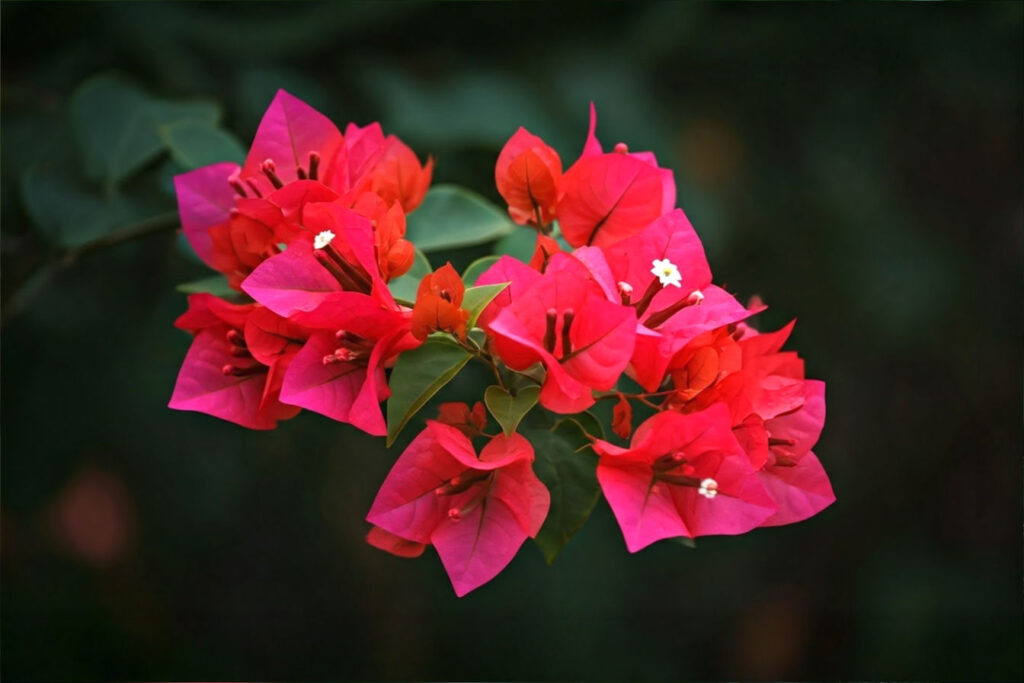
A Bract-iful Display
Don’t be fooled—the real stars here aren’t flowers but bracts: papery, vibrant sheaths in shocking magenta, deep purple, fiery orange, or even white, pink, or red, depending on the variety. These Technicolor wonders wrap tiny, white blooms inside, creating a floral illusion that screams from rooftops, fences, or pergolas. In Zones 11-13’s endless summer, they bloom relentlessly—peaking in dry seasons and slowing (but never stopping) when rains hit. Thorny stems and evergreen leaves add a rugged edge, making it a lush, living tapestry.
Sun-Soaked Survivor
Bougainvillea is a heat-seeking missile—it demands full sun (six hours minimum) and revels in the scorching, humid glory of Zones 11-13, from Miami’s coast to Hawaii’s hills. Soil? It’s not picky—poor, dry, rocky, or sandy works fine, as long as it drains fast. Rich dirt makes it leafy but bloom-shy; lean and mean is its vibe. Once established, it’s a drought-loving diva—perfect for tropical gardeners who’d rather lounge than water.
Planting and Care: Let It Loose
Spring’s your launchpad—set it near a trellis, fence, or wall where it can climb or sprawl, planting it with the root ball slightly above soil level for drainage. Water deeply—an inch or two—weekly for the first month to settle its roots, then dial back to every two weeks (or less if rains are generous). Prune lightly after big bloom flushes to tame its wild heart—snip for shape, not size, unless you’re training it hard. Gloves are your friend; those thorns bite. Fertilize sparingly—too much food turns it into a green monster with no flowers.
Year-Round Revelry
In Zones 11-13, Bougainvillea doesn’t clock out. Bracts flare brightest in dry, sunny stretches—think spring and fall—but even wet seasons can’t fully dim its glow. Left unpruned, it’ll swallow structures in a glorious tangle; trimmed, it’s a sculpted masterpiece. Its woody vines twist and tumble, perfect for arbors, patios, or cascading over cliffs. Pair it with hibiscus, plumeria, or palms for a tropical overdose that defines island life.
Wildlife and Edge
Butterflies and hummingbirds sip from the hidden blooms, though it’s more a visual feast than a pollinator buffet. Birds might nest in its thickets, and its thorns deter deer or nosy critters—a natural barbed wire with better aesthetics. Those bracts? They flutter like confetti in the breeze, earning the “paper flower” nickname and a starring role in tropical lore.
Roots and Rep
Hailing from South America, Bougainvillea was named for French explorer Louis de Bougainville and exploded across the tropics—think Mediterranean villas, Caribbean courtyards, and Balinese resorts. In Zones 11-13, it’s the poster plant for warm-climate bravado, draping homes and highways with fearless color. Dwarf varieties like ‘Raspberry Ice’ tame it for pots, while classics like ‘Barbara Karst’ run rampant.
Watch Out For
Bougainvillea’s a beast, but soggy soil rots its roots—drainage is life. Shade or overwatering cuts its blooms; sun and dry feet are non-negotiable. Aphids or caterpillars might nibble—blast them off or use soap spray. Pruning’s a dance—too much, and you lose the magic; too little, and it’s a jungle. In rare Zone 11 chills (below 35°F), it might sulk but usually rebounds.
Why It’s a Tropical Titan
Bougainvillea is Zones 11-13’s wild card: explosive color, untamed energy, and a love for neglect that matches the laziest gardener’s dreams. It’s a living mural—climb it, shape it, or let it run free—and it’ll still steal the show. Whether you’re sipping a mai tai or dodging its thorns, this dazzler defines tropical swagger. Ready to let it climb into your life?
Elephant Ear (Colocasia esculenta)
Common Names: Taro, Cocoyam, Dasheen
Step into the jungle with Elephant Ear—a tropical titan that brings prehistoric drama to Zones 11-13. Towering 3-6 feet tall (sometimes more in the right mood), this stunner unfurls massive, heart-shaped leaves that flop and sway like nature’s own green sails. It’s not subtle—it’s a loud, proud declaration of the tropics, thriving in the steamy heat and humidity of places like South Florida, Hawaii, or the Gulf Coast.
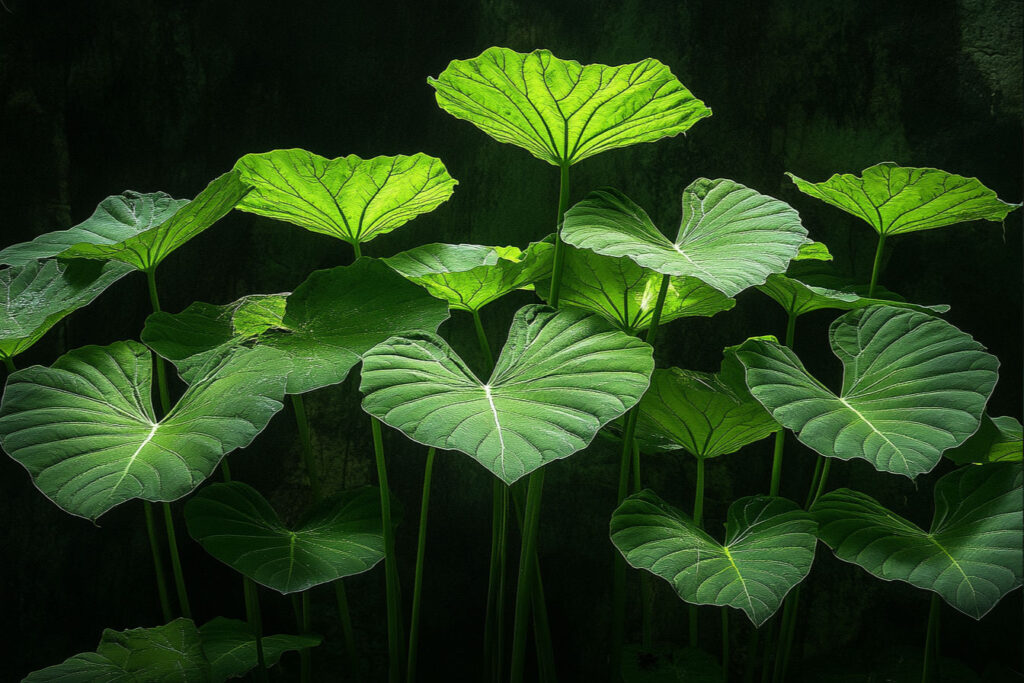
Leaves That Roar
Picture this: leaves up to 3 feet long and 2 feet wide, shaped like giant hearts with veins that ripple like rivers. They’re a glossy, deep green—sometimes tinged with purple or black in funky cultivars—drooping downward as if bowing to the rainforest gods. Held aloft on thick, juicy stems, they catch the light and cast shadows that scream “wild.” In Zones 11-13’s endless growing season, they keep pumping out foliage, turning any corner into a lush, primeval escape.
Humidity Hugger
Elephant Ear is a moisture maven—partial shade is its jam (think dappled light under palms), though it’ll take full sun if the water’s plentiful. It craves rich, moist soil—loamy or mucky with organic oomph—and slurps up the humidity that defines Zones 11-13. Dry spells? Not its scene; it wants damp roots and a steamy vibe to flex its full potential. Heat’s no hurdle—it revels in the sultry summers that wilt lesser plants.
Planting and Care: Wet and Wild
Spring’s your cue—plant bulbs (corms) or nursery starts when the soil’s warm, spacing them 2-4 feet apart to give those leaves room to stretch. Bury corms 2-4 inches deep, pointy end up, in a hole enriched with compost, and water deeply—aim for consistently damp soil, like a weekly soaking (more if the tropics turn scorching). Mulch helps lock in moisture; think of it as a spa treatment for the roots. Snip off yellowing leaves to keep it sharp—otherwise, it grows like a dream, soaking up the heat with zero fuss.
Year-Round Jungle Juice
In Zones 11-13, Elephant Ear doesn’t mess with downtime. Spring sparks new growth, summer explodes into full leafy glory, and even the mild “winters” barely slow it down—those leaves keep unfurling as long as it’s warm and wet. It’s a natural for water gardens, pond edges, or shady patios; pair it with hibiscus, ferns, or gingers for a tropical overload that feels straight out of Jurassic Park. Rarely, it might toss out a calla-like flower—cool, but the leaves are the real headliner.
Wildlife and Roots
Frogs and lizards love lounging under its canopy, while birds might perch on its sturdy stalks. It’s not a pollinator magnet—those leaves are the draw, not nectar—but it adds habitat vibes. Edible? You bet: the corms are taro, a starchy staple in Polynesian and Caribbean kitchens (boil or roast, never raw—toxins need cooking out). Native to Southeast Asia, it’s been a global traveler, feeding cultures and fueling gardens for centuries.
Watch Out For
Elephant Ear’s a diva about moisture—too dry, and it droops; too soggy without drainage, and it rots. Full shade dims its size; give it some light to strut. Pests like spider mites or aphids might creep in—hose them off or use soap spray. In rare Zone 11 cold dips (below 50°F), it might sulk; mulch or move pots indoors if frost dares to whisper. All parts are toxic raw—keep pets and kids from nibbling.
Why It’s a Tropical Must
Elephant Ear is Zones 11-13’s green giant: oversized, over-the-top, and oozing jungle swagger. It’s low-effort drama—plant it, water it, and watch it transform your space into a humid haven. Whether you’re channeling a rainforest retreat or just flexing some foliage, this beast delivers. Ready to let it stomp into your garden?
Beginner Tip: Watch for overwatering—let the top inch of soil dry out between sessions. These plants love moisture but hate soggy roots, so balance is your friend.
Conclusion
Gardening kicks off with a simple truth: the right plant in the right zone sets you up to win. The USDA Plant Hardiness Zones map out America’s climates, from the icy grip of Zones 1-4 to the steamy embrace of Zones 11-13, and every spot in between. Beginners don’t need green thumbs—just smart picks tailored to their weather. This guide hands you those picks, proving you can grow something stunning no matter where you stand.
In the cold reaches of Zones 1-4, Paper Birch towers with rugged grace, Coneflower paints the short summer purple, and Pansy braves early frosts. Move to the temperate Zones 5-7, and Black-Eyed Susan glows gold, Lavender perfumes the air, and Daylily keeps blooming without a fuss. Down in the warm Zones 8-10, Rosemary flavors your meals, Marigold lights up long seasons, and Crepe Myrtle anchors your yard with flair. And in the tropical Zones 11-13, Hibiscus explodes with color, Bougainvillea climbs wild, and Elephant Ear unfurls its giant leaves year-round. Each plant shrugs off beginner mistakes, thriving with basic care across America’s diverse climates.
Start small—grab one or two from your zone’s lineup. Dig a hole, plant them right, and water them in. You’ll see them take root and grow, building your confidence with every leaf. These choices don’t demand fancy tools or endless hours. They ask for sunlight, a little water, and a touch of patience—things you already bring to the table. Whether you’re dodging blizzards or basking in endless heat, your zone holds a winner waiting to sprout.
Experiment as you go. Swap a Pansy for a second Coneflower, or pair Rosemary with Marigold for a fragrant border. Gardening bends to your style, and these plants flex with you. They forgive forgotten waterings, bounce back from light neglect, and reward you with blooms, scents, or shade. Every success—big or small—teaches you more, turning a patch of dirt into your own green escape.
Find your zone today and pick your first plant. Head to the USDA website, punch in your ZIP code, and see your number pop up. Match it to this guide, then hit the nursery or order online. You’re not just planting—you’re starting a journey. Grab a shovel, get your hands dirty, and grow something great. Your yard’s ready, and so are you.

